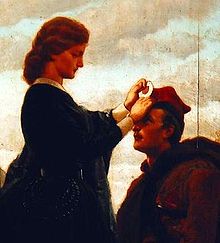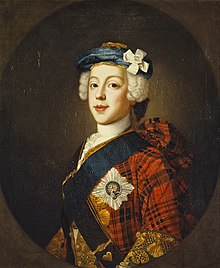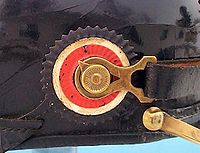Cockade



Acockadeis a knot of ribbons, or other circular- or oval-shaped symbol of distinctive colours which is usually worn on ahatorcap.
The word cockade derives from the Frenchcocarde,from Old Frenchcoquarde,feminine ofcoquard(vain, arrogant), fromcoc(cock), of imitative origin. The earliest documented use was in 1709.[1][2]
Eighteenth century
[edit]

In the 18th and 19th centuries, coloured cockades were used in Europe to show the allegiance of their wearers to some political faction, or to show their rank or to indicate a servant's livery.[3][4]Because individual armies might wear a variety of differing regimentaluniforms,cockades were used as an effective and economical means of national identification.[5]
A cockade was pinned on the side of a man'stricorneorcocked hat,or on his lapel. Women could also wear it on their hat or in their hair.
In pre-revolutionary France, the cockade of theBourbondynasty was all white.[6][7][8]In theKingdom of Great Britainsupporters of aJacobiterestoration wore white cockades, while the recently establishedHanoverianmonarchy used a black cockade.[9][10][11][12]The Hanoverians also accorded the right to all German nobility to wear the black cockade in the United Kingdom.
During the 1780Gordon Riotsin London, the blue cockade became a symbol of anti-government feelings and was worn by most of the rioters.[13][14][15][16][17][18][19][20]
During theAmerican Revolution,theContinental Armyinitially wore cockades of various colors as anad hocform of rank insignia, as GeneralGeorge Washingtonwrote:
As the Continental Army has unfortunately no uniforms, and consequently many inconveniences must arise from not being able to distinguish the commissioned officers from the privates, it is desired that some badge of distinction be immediately provided; for instance that the field officers may have red or pink colored cockades in their hats, the captains yellow or buff, and thesubalternsgreen.[21][22]
Before long however, the Continental Army reverted to wearing the black cockade they inherited from the British. Later, whenFrance became an ally of the United States,the Continental Army pinned the white cockade of the FrenchAncien Régimeonto their old black cockade; the French reciprocally pinned the black cockade onto their white cockade, as a mark of the French-American alliance. The black-and-white cockade thus became known as the "Union Cockade".[23][24][25][26][27]
In theStorming of the Bastille,Camille Desmoulinsinitially encouraged the revolutionary crowd to wear green. This colour was later rejected as it was associated with theCount of Artois.Instead, revolutionaries would wear cockades with the traditional colours of thearms of Paris:red and blue. Later, the Bourbon white was added to this cockade, thus producing the originalcockade of France.[26]Later, distinctive colours and styles of cockade would indicate the wearer's faction; although the meanings of the various styles were not entirely consistent, and they varied somewhat by region and period.
European military
[edit]

From the 15th century, variousEuropeanmonarchy realms used cockades to denote the nationalities of their militaries.[28][29]Their origin reverts to the distinctive colored band or ribbon worn by late medieval armies or jousting knights on their arms or headgear to distinguish friend from foe in the field of battle. Ribbon-style cockades were worn later upon helmets and brimmed hats ortricornesandbicornesjust as the French did, and also oncocked hatsandshakoes.Coloured metal cockades were worn at the right side ofhelmets;while small button-type cockades were worn at the front ofkepisand peaked caps.[30][31]In addition to the significance of these symbols in denoting loyalty to a particular monarch, the coloured cockade served to provide a common and economical field sign at a time when the colours of uniform coats might vary widely between regiments in a single army.[32]
During theNapoleonic wars,the armies ofFranceandRussia,had the imperial French cockade or the larger cockade ofSt. Georgepinned on the front of theirshakos.[33]
The SecondGerman Empire(1870–1918) used two cockades on each army headgear: one (black-white-red) for the empire; the other for one of the monarchies the empire was composed of, which had used their own colors long before. The only exceptions were the Kingdoms of Bavaria and Württemberg, having preserved the right to keep their own armed forces which were not integrated in the Imperial Army. Their only cockades were either white-blue-white (Bavaria) or black-red-black (Württemberg).[34][3][35]
TheWeimar Republic(1919–1933) removed these, as they might promote separatism which would lead to the dissolution of the German nation-state into regional countries again.[36] When theNaziscame to power, they rejected the democratic German colours ofblack-red-goldused by the Weimar Republic. Nazis reintroduced the imperial colours (in German:die kaiserlichen FarbenorReichsfarben) of black on the outside, white next, and a red center. The Nazi government usedblack-white-redon all army caps.[37]These colours represented the biggest and the smallest countries of the Reich: large Prussia (black and white) and the tinyHanseatic Leaguecity statesof Hamburg, Bremen and Lübeck (white and red).
France began the firstAir Servicein 1909 and soon picked the traditional French cockade as the first national emblem, now usually termed aroundel,on military aircraft. During World War I, other countries adopted national cockades and used these coloured emblems as roundels on their military aircraft. These designs often bear an additional central device or emblem to further identify national aircraft, those from theFrench navybearing a black anchor within the French cockade.[38]
Hungarianrevolutionaries wore cockades during theHungarian revolution of 1848and during the1956 revolution.Because of this, Hungarians traditionally wear cockades on 15 March.[39][40]
Confederate States
[edit]Echoing their use when Americans rebelled against Britain, cockades – usually made with blue ribbons and worn on clothing or hats – were widespread tokens ofSouthernsupport forsecessionpreceding theAmerican Civil Warof 1861–1865.[41]
List of national cockades
[edit]
Below is a list of national cockades (colors listed from center to ring):[42][43]
| Country and date |
Description | Image |
|---|---|---|
| red-black-red | ||
| sky blue-white-sky blue | ||
| orange-blue-red | ||
before 1918 |
black-gold | |
since 1918 |
red-white-red | |
| green-red-light blue | ||
| black-yellow-red | ||
(1825–1826) |
green-red-green (with a white 5 pointed star in the center) | |
(1826–1851) |
green-red-yellow | |
| green-yellow-red | ||
| blue-yellow-green | ||
| red-green-white | ||
| blue-white-red (with a white 5 pointed star in the blue portion) | ||
| yellow-blue-red | ||
| red-white-blue | ||
(1920–1993) |
blue-red-white | |
| blue-red-white | ||
(early 19th century) |
black | |
| red-white-red | ||
| red-blue-yellow | ||
(1922–1953) |
green-white-green | |
| black-white-red | ||
| white-black-blue | ||
(until 1936) |
green-yellow-red | |
| red-yellow-green | ||
| white-blue-white | ||
(1794–1814, 1815 and current since 1830) |
blue-white-red | |
(before 1794, 1814–1815 and 1815–1830) |
white | |
| green-yellow-light blue | ||
(1990–2004) |
black-white-wine red | |
(1848–1871) |
gold-red-black | |
| red-white-black | ||
(1956–1959) |
black-red-gold | |
| black-red-gold | ||
| green-yellow-red | ||
(1822) |
white-blue-white | |
(1833) |
blue-white | |
| blue-white | ||
| green-white-red | ||
| blue-white-red-white-blue | ||
| green-white-saffron | ||
| red-white-green | ||
(until 1922) |
green or sky blue | |
(since 1922) |
green-white-orange | |
(1861–1948) |
savoy blue | |
(since 1948) |
green-white-red | |
| red-white | ||
| green-white-red-white-black | ||
| carmine-white-carmine | ||
| red-green-yellow | ||
| green-white-red | ||
| white-red-white | ||
| orange | ||
| green-white-green | ||
| red-white-blue-white | ||
| white-green-yellow | ||
| blue-white-red | ||
| red-white-red | ||
(1898–1901) |
red-blue-silver | |
| red-white | ||
(1797–1820 and 1823–1830) |
blue-red | |
(1821–1823 and 1830–1910) |
blue-white | |
| green-red | ||
| blue-yellow-red | ||
(until 1917) |
black-orange-black-orange-white | |
| black-orange-black-orange | ||
| white-blue | ||
| red-blue-white | ||
(1978–1996) |
green-white-red | |
| light blue-white-green | ||
| red-blue-white | ||
(until 1843 and 1844–1871) |
red | |
(1843–1844 and current since 1871) |
red-yellow-red | |
(military) |
yellow | |
(civilian) |
blue-yellow | |
| red-white-blue-white-red | ||
| green-red-white-blue | ||
| red-white-red | ||
| light blue-yellow | ||
| white(Stuart dynasty),black(Hanoverian dynasty),red-white-blue | ||
(War of Independence) |
black-white-black | |
(19th century) |
blue with an eagle in the centre | |
| white-blue-red | ||
(1828–1916) |
sky blue | |
(civilian) |
blue-white-blue-white-blue-white-blue-white | |
(military) |
blue-white-blue with a red diagonal line | |
(police) |
red-white-blue | |
| red-blue-yellow | ||
| blue-white-red |
Component states of the German Empire (1871–1918)
[edit]
TheGerman Empirehad, besides the national cockade, also cockades forseveral of its states,[44]seen in the following table:
| State | Description |
|---|---|
| Anhalt | green |
| Baden | yellow-red-yellow |
| Bavaria | white-sky blue-white |
| Brunswick | blue-yellow-blue |
| Hanseatic cities(Bremen,Hamburg,Lübeck) | white with a red cross |
| Hesse | white-red-white-red-white |
| Lippe | yellow-red-yellow |
| Mecklenburg-Schwerinand-Streliz | red-yellow-blue |
| Oldenburg | blue-red-blue |
| Prussia | black-white-black |
| Reuss-Geraand-Greiz | black-red-yellow |
| Saxe-Altenburg,-Coburg and Gothaand-Meiningen | green-white-green |
| Saxe-Weimar | black-yellow-green |
| Saxony | white-green-white |
| Schaumburg-Lippe | blue-red-white |
| Schwarzburg-Rudolstadt | blue-white-blue |
| Schwarzburg-Sonderhausen | white-blue-white |
| Waldeck | black-red-yellow |
| Württemberg | black-red-black |
See also
[edit]References
[edit]- ^"Cockade".
- ^"The American Heritage Dictionary entry: Cockade".
- ^abMaxwell, A. (2014).Patriots Against Fashion: Clothing and Nationalism in Europe's Age of Revolutions.Palgrave Macmillan UK.ISBN9781137277145.Retrieved2017-03-05.
- ^Newman, S.P. (2010).Parades and the Politics of the Street: Festive Culture in the Early American Republic.University of Pennsylvania Press, Incorporated. p. 161.ISBN9780812200478.Retrieved2017-03-05.
- ^Mollo, John (1972).Military Fashion.Barrie and Jenkins. p. 22.ISBN0-214-65349-8.
- ^The White Cockade; Or, Bourbon Songster: Being a Patriotic Collection of Songs on the Downfall of Tyranny, and Restoration of Louis XVIII., Etc. [A Chap-book.].J. Evans & Son. 1814. p. 2.Retrieved2017-03-05.
- ^Cobbett, W. (1814).Cobbett's Political Register.Vol. 25. William Cobbett.Retrieved2017-03-05.
- ^Jones, C. (2006).Paris: Biography of a City.Penguin Books Limited.ISBN9780141941912.Retrieved2017-03-05.
- ^Cormack, W.S. (2002).Revolution and Political Conflict in the French Navy 1789-1794.Cambridge University Press. p. 65.ISBN9780521893756.Retrieved2017-03-05.
- ^Hofschröer, P.; Fosten, B. (2012).The Hanoverian Army of the Napoleonic Wars.Bloomsbury Publishing.ISBN9781780965178.Retrieved2017-03-05.
- ^Jones, G.M. (1827).Travels in Norway, Sweden, Finland, Russia and Turkey: also on the coasts of the sea of Azof and of the Black sea; with a review of the trade in those seas, and of the systems adopted to man the fleets of the different powers of Europe, compared with that of England.J. Murray. p.22.Retrieved2017-03-05.
- ^Franklin, C. (2012).British Army Uniforms of the American Revolution 1751-1783.Pen & Sword Books Limited. p. 111.ISBN9781848846906.Retrieved2017-03-05.
- ^Babington, A. (2015).Military Intervention in Britain: From the Gordon Riots to the Gibraltar Incident.Taylor & Francis. p. 21.ISBN9781317397717.Retrieved2017-03-05.
- ^Stockdale, J.J. (1810).The Covent Garden Journal...J.J. Stockdale. p. 130.Retrieved2017-03-05.
- ^Livingston, D.W. (1998).Philosophical Melancholy and Delirium: Hume's Pathology of Philosophy.University of Chicago Press. p. 275.ISBN9780226487175.Retrieved2017-03-05.
- ^Popular educator (1767).The popular educator.p. 254.Retrieved2017-03-05.
- ^Bloom, C. (2012).Riot City: Protest and Rebellion in the Capital.Palgrave Macmillan. p. 147.ISBN9781137029362.Retrieved2017-03-05.[permanent dead link]
- ^Walker, G.; Verhoeven, W.M. (2004).The Vagabond.Broadview Press. p. 253.ISBN9781460404256.Retrieved2017-03-05.
- ^CLIFFORD, H.; Brandon, J. (1809).Clifford for ever! O.P. and no P.B. The Trial between H. Clifford, plaintiff, and J. Brandon, defendant, for an assault and false imprisonment, etc.John Fairburn. p. 19.Retrieved2017-03-05.
- ^Haywood, I.; Seed, J. (2012).The Gordon Riots: Politics, Culture and Insurrection in Late Eighteenth-Century Britain.Cambridge University Press. p. 107.ISBN9780521195423.Retrieved2017-03-05.
- ^"Defense.gov News Article: Insignia: The Way You Tell Who's Who in the Military".archive.defense.gov. Archived fromthe originalon 2018-01-23.Retrieved2017-03-05.
- ^Force, P. (1844).American archives.Рипол Классик. pp. 2–1745.ISBN9785885286961.Retrieved2017-03-05.
- ^Field, R.; Hook, A. (2013).LincolnÂ?s 90-Day Volunteers 1861: From Fort Sumter to First Bull Run.Bloomsbury Publishing. p. 47.ISBN9781782009214.Retrieved2017-03-05.
- ^Richards, J.H. (1997).Early American Drama.Penguin Publishing Group. p. 68.ISBN9781101177211.Retrieved2017-03-05.
- ^Winkle, K.J. (2013).Lincoln's Citadel: The Civil War in Washington, DC.W. W. Norton.ISBN9780393240573.Retrieved2017-03-05.
- ^abMaxwell, A. (2014).Patriots Against Fashion: Clothing and Nationalism in Europe's Age of Revolutions.Palgrave Macmillan UK.ISBN9781137277145.Retrieved2017-03-05.
- ^Fahs, A. (2010).The Imagined Civil War: Popular Literature of the North and South, 1861-1865.University of North Carolina Press. p. 43.ISBN9780807899298.Retrieved2017-03-05.
- ^ADYE, R.W. (1802).The Little Bombardier, and Pocket Gunner. By Ralph Willett Adye.T. Egerton. p. 271.Retrieved2017-03-05.
- ^Troiani, D.; Kochan, J.L.; Coates, J.; Kochan, J. (1998).Don Troiani's Soldiers in America, 1754-1865.Stackpole Books. p.99.ISBN9780811705196.Retrieved2017-03-05.
- ^Stone, D. (2015).The Kaiser's Army: The German Army in World War One.Bloomsbury Publishing.ISBN9781844862924.Retrieved2017-03-05.
- ^Kidd, R.S. (2013).MILITARY UNIFORMS IN EUROPE 1900 - 2000 Volume One.LULU Press. p. 128.ISBN9781291187441.Retrieved2017-03-05.
- ^Mollo, John (1972).Military Fashion.pp. 30–31.ISBN0-214-65349-8.
- ^Dempsey, G. (2002).Napoleon's Mercenaries: Foreign Units in the French Army Under the Consulate and Empire, 1799-1814.Greenhill Books. p. 267.ISBN9781853674884.Retrieved2017-03-05.
- ^Kidd, R.Spencer (October 2013).Military Uniforms in Europe 1900-2000 Vol. One.p. 5.ISBN978-1-291-18744-1.
- ^D, D.T.Z.P. (2014).Germany at War: 400 Years of Military History [4 volumes]: 400 Years of Military History.ABC-CLIO. p. 494.ISBN9781598849813.Retrieved2017-03-05.
- ^Williamson, G.; Pavlovic, D. (2012).U-Boat Crews 1914–45.Bloomsbury Publishing.ISBN9781780967905.Retrieved2017-03-05.
- ^de Quesada, A.; Dale, C.; Walsh, S. (2013).Imperial German Colonial and Overseas Troops 1885?1918.Bloomsbury Publishing. p. 47.ISBN9781780961651.Retrieved2017-03-05.
- ^Cooke, J.J. (1996).The U.S. Air Service in the Great War, 1917-1919.Praeger. p. 202.ISBN9780275948627.Retrieved2017-03-05.
- ^Wöll, A.; Wydra, H. (2007).Democracy and Myth in Russia and Eastern Europe.Taylor & Francis. p. 182.ISBN9781134089086.Retrieved2017-03-05.
- ^Gyarfasova, O.; Liebhart, K. (2014).Constructing and Communicating Europe.Lit Verlag. p. 202.ISBN9783643905154.Retrieved2017-03-05.
- ^Goodheart, Adam (November 15, 2010)."Female Partisans"(blog).The New York Times.RetrievedOctober 14,2022.
- ^"Tableau comparatif de la superficie, population totale et pop. par m. géogr. de tous les Etats du monde, avec les cocardes et pavillons les plus connus / dressé d'après Malte-Brun, Hassel, Balbi et autres sources authentiques par C. Desjardins; A. Haas, script"(in French). Gallica. 1833.Retrieved2017-03-05– via gallica.bnf.fr.
- ^"Tableau comparatif de la superficie et de la population absolue et relative de tous les Etats du monde avec leurs pavillons et cocardes / dressé d'après les documens les plus récens par Ct. Desjardins,...; Lith. de Mantoux,..."(in French). Gallica. 1842.Retrieved2017-03-05– via gallica.bnf.fr.
- ^Hein.Das kleine Buch vom Deutschen Heere 1901.
Further reading
[edit]External links
[edit] Media related toCockadesat Wikimedia Commons
Media related toCockadesat Wikimedia Commons
